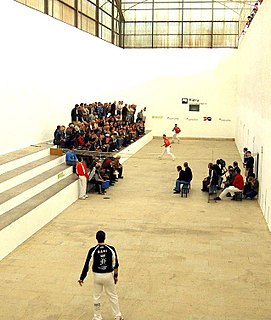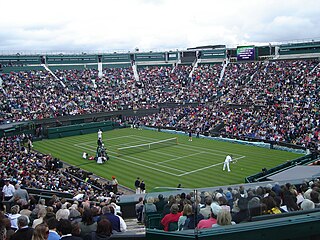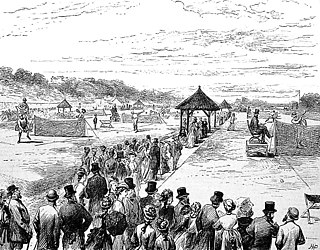
The province of Grosseto is a province in the Tuscany region of Italy. Its capital is the city of Grosseto. As of 2013 the province had a total population of 225,098 people.

Tennis is a racket sport that is played either individually against a single opponent (singles) or between two teams of two players each (doubles). Each player uses a tennis racket that is strung with cord to strike a hollow rubber ball covered with felt over or around a net and into the opponent's court. The object of the game is to manoeuvre the ball in such a way that the opponent is not able to play a valid return. The player who is unable to return the ball validly will not gain a point, while the opposite player will.

Jeu de paume, nowadays known as real tennis, (US) court tennis or courte paume, is a ball-and-court game that originated in France. It was an indoor precursor of tennis played without racquets, and so "game of the hand", though these were eventually introduced. It is a former Olympic sport, and has the oldest ongoing annual world championship in sport, first established over 250 years ago. The term also refers to the court on which the game is played and its building, which in the 17th century was sometimes converted into a theatre.

Real tennis – one of several games sometimes called "the sport of kings" – is the original racquet sport from which the modern game of tennis is derived. It is also known as court tennis in the United States, formerly royal tennis in England and Australia, and courte-paume in France. Many French real tennis courts are at jeu de paume clubs.

Tennis for Two is a sports video game that simulates a game of tennis, and was one of the first games developed in the early history of video games. American physicist William Higinbotham designed the game in 1958 for display at the Brookhaven National Laboratory's annual public exhibition after learning that the government research institution's Donner Model 30 analog computer could simulate trajectories with wind resistance. He designed the game within a few hours, after which he and technician Robert V. Dvorak built it over a period of three weeks. The game was displayed on an oscilloscope and played with two custom aluminum controllers. Its visuals show a representation of a tennis court viewed from the side, and players adjust the angle of their shots with a knob on their controller and try to hit the ball over the net by pressing a button.

Castiglione della Pescaia, regionally simply abbreviated as Castiglione, is an ancient seaside town in the province of Grosseto, in Tuscany, central Italy. The modern city grew around a medieval 12th century fortress and a large fishery, from which it acquired its designation. Today Castiglione is a very popular tourist destination with attractions that include beaches, natural parks, biking trails, historical Etruscan archaeological sites, a panoramic mediaeval hamlet as well as the natural reserve Diaccia Botrona, a swampy humid environment of historical relevance whose endangered wildlife comprise pink flamingoes, mallards and ducks.
Pallone is the name of several traditional ball games, played in all regions of Italy, with few differences in regulations.
A point in tennis is the smallest subdivision of the match. A point can consist of a double fault by the server, in which case the point is automatically won by the receiver. In all other cases, a point begins when a legal serve is hit by the server to the receiver on the opposite side of the court, and continues until one side fails to legally return the ball to the opposite side. Whichever side fails to do so loses the point and their opponent wins it.
This page is a glossary of tennis terminology.
Traditionally, tennis is played between two people in a singles match, or two pairs in a doubles match. Tennis can also be played on different courts, including grass courts, clay courts, hard courts, and artificial grass courts.

Gavorrano is a mountain-side comune (municipality) in the Province of Grosseto in the western Italian region of Tuscany, located about 100 km (62 mi) southwest of Florence and about 25 km (16 mi) northwest of Grosseto. Gavorrano borders the municipalities of Castiglione della Pescaia, Grosseto, Massa Marittima, Roccastrada and Scarlino.

Valencian pilota is a traditional handball sport played in the Valencian Community. Its origins are not known.

Escala i corda is the most prestigious variant of Valencian pilota, and the only one apart from raspall to have professional players.

The racket sport traditionally named lawn tennis, invented in Birmingham, England now commonly known simply as tennis, is the direct descendant of what is now denoted real tennis or royal tennis, which continues to be played today as a separate sport with more complex rules. Most rules of (lawn) tennis derive from this precursor and it is reasonable to see both sports as variations of the same game. Most historians believe that tennis was originated in the monastic cloisters in northern France in the 12th century, but the ball was then struck with the palm of the hand; hence, the name jeu de paume. It was not until the 16th century that rackets came into use, and the game began to be called "tennis." It was popular in England and France, and Henry VIII of England was a big fan of the game, now referred to as real tennis.

The 1877 Wimbledon Championship was a men's tennis tournament held at the All England Croquet and Lawn Tennis Club in Wimbledon, London. It was the world's first official lawn tennis tournament, and was later recognised as the first Grand Slam tournament or "Major". The AEC & LTC had been founded in July 1868, as the All England Croquet Club; lawn tennis was introduced in February 1875 to compensate for the waning interest in croquet. In June 1877 the club decided to organise a tennis tournament to pay for the repair of its pony roller, needed to maintain the lawns. A set of rules was drawn up for the tournament, derived from the first standardised rules of tennis issued by the Marylebone Cricket Club in May 1875.

Foro Italico is a sports complex in Rome, Italy, on the slopes of Monte Mario. It was built between 1928 and 1938 as the Foro Mussolini under the design of Enrico Del Debbio and, later, Luigi Moretti. Inspired by the Roman forums of the imperial age, its design is lauded as a preeminent example of Italian fascist architecture instituted by Mussolini. The purpose of the prestigious project was to get the Olympic Games of 1940 to be organised by fascist Italy and held in Rome.
The following outline is provided as an overview of and topical guide to tennis. Tennis is a sport usually played between two players (singles) or between two teams of two players each (doubles). Each player uses a specialized racquet that is strung to strike a hollow rubber ball covered with felt over a net into the opponent's court.
Galotxa is a variety of pilota that is always played in the street, whether artificial or natural, practiced mostly in the northern counties of the Xúquer river.

A serve in tennis is a shot to start a point. A player will hit the ball with a racquet so it will fall into the diagonally opposite service box without being stopped by the net. Normally players begin a serve by tossing the ball into the air and hitting it. The ball can only touch the net on a return and will be considered good if it falls on the opposite side. If the ball contacts the net on the serve but then proceeds to the proper service box, it is called a let; this is not a legal serve in the major tours although it is also not a fault. Players normally serve overhead; however serving underhand is allowed. The serve is the only shot a player can take their time to set up instead of having to react to an opponent's shot; however, as of 2012, there is a 25-second limit to be allowed between points.

Follis, a term used in the Ancient Rome, or Ball of Wind, a term used in the 15th and 16th centuries in Spain and Italy, was a hollow ball, inflated with air under pressure, which allowed the ball to jump and bounce when impacting at a certain speed with any solid body. The different types of balls of wind were commonly used to play a variety of ball games that were popular on that particular period of time.













